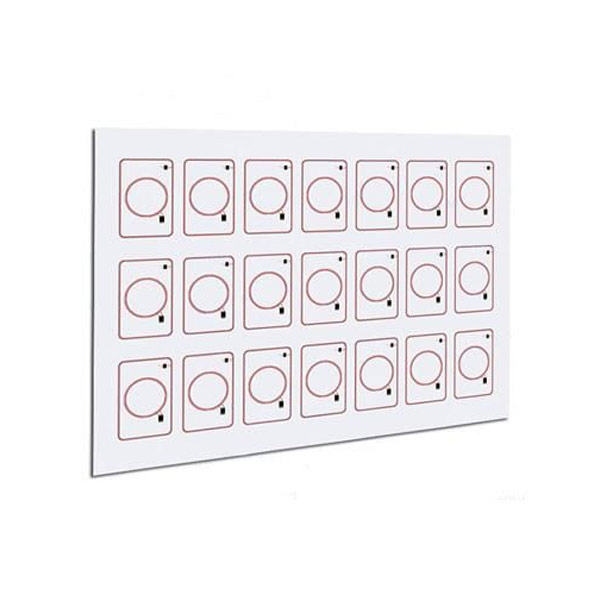ID card (Smartcard): a general term for a plastic card (usually the size of a credit card) embedded with a microchip. Some ID cards contain RFID chips, so they can identify the cardholder without any physical contact with the reader.
An ID card is a type of IC card (integrated circuit card). According to the type of embedded chip, IC cards can be divided into three categories: 1. Memory cards: the integrated circuit in the card is programmable, read-only storage EEPROM, only data storage function, no data processing capability; memory card itself has no hardware encryption function, only encryption on the file, easy to crack.

ID card is equipped with CPU and RAM, which can process a large amount of data without interfering with the work of the host CPU. It is suitable for applications with large number of ports and fast communication speed. To reduce the burden on the host CPU, ID cards can also filter erroneous data.
2. Logic encryption card: the integrated circuit in the card includes encryption logic circuit and programmable read-only memory EEPROM. encryption logic circuit can protect the card and the data in the card to a certain extent, but it is only low-level protection and cannot prevent malicious attacks.
3. ID card (CPU card): the data in the card is divided into external reading and internal processing to ensure that the data in the card is safe and reliable. the integrated circuit in the card includes the central processor CPU, programmable read-only memory EEPROMM, random memory RAM cured in the read-only memory ROM and the card operating system COS (ChipOperatingSystem).
Second, IC card-related specifications
IC card is a very standardized product, its appearance, the electrical characteristics of the internal chip, and even its application method are controlled by some more strict protocols. This protocol specifies not only the mechanical and electrical characteristics of IC cards, but also the application methods (including many data structures in COS) for IC cards (especially ID cards).
in addition to the 7816 protocol, there are a number of more specific protocols that may be applied to specific areas of IC cards. For example, in China, the PBOC specification, the traffic management system, and the social welfare system have their own specific specifications. these protocol specifications are based on the 7816 protocol and specifically form the 7816 protocol.
of course, the 7816 protocol does not exist (defined) independently, and many of its concepts are derived from other related protocol specifications. For example, the 7816 protocol uses some data organization "BER-TLV", and the detailed description of the concept "BER-TLV" is given in the protocol by IEC8825ASN. As can be seen, the 7816 protocol is not entirely original and does not make itself known on the occasions when it can adopt the concept of specification. This has led to a strict system of various protocol specifications.
Fourth, what is the use of ID cards?
in terms of function, the use of ID cards can be divided into the following four points.
1、Identity identification
2、Payment tool
3、Encryption / decryption
4、information
Third, what is the operating system of ID card?
ID card operating system is usually called chip operating system COS. cos usually has its own security system, and its security performance is usually an important technical indicator to measure cos. cos functions include: transmission management, file management, security system, command interpretation.
History of ID card development
IC card is an integrated circuit card (integratedCircuitcard) in some countries, it is also known as ID card, ID card, microchip card, etc.. A special integrated circuit chip is embedded in a PVC (or ABS, etc.) plastic substrate that meets ISO7816 standards and packaged in the form of a card similar in shape to a magnetic card, that is, made into an IC card. of course, it can also be packaged into special shapes such as buttons, keys, and jewelry.
in December 1969, Kunitaka Arimura of Japan proposed a safe and reliable method of manufacturing credit cards, which was patented in 1970 and was then called ID card (Identificationcard). 1974, Roland Moreno of France ( in 1974, Roland Moreno invented and patented a plastic card with an integrated circuit chip, the early IC card. 1976, Bull (France), the company developed the worlds first IC card. 1984, France PTT (Posts,TelegraphsandTelephones) due to the IC card has good security and in 1984, PTT (Posts,TelegraphsandTelephones) in France used IC cards for telephone cards with unexpected success due to their good security and reliability. Subsequently, the joint technical committee of the international Organization for Standardization (ISO, international Standardization Organization) and the international Electrotechnical Commission (IEC, international Electrotechnical Commission) developed a series of international standards and specifications, which has greatly promoted the research and development of IC cards.
Compared with the previous identification card, IC card has the following characteristics: First, high reliability - IC card has the ability of anti-magnetic, anti-static, anti-mechanical damage, anti-chemical damage. information can be saved for more than 100 years, and the number of reading and writing is more than 100,000 times, at least 10 years; second, good security; third, large storage capacity; fourth, there are many types. From a global perspective, the application of IC card is no longer limited to the early communication field, but widely used in finance, social insurance, transportation and tourism, medical and health care, government administration, commodity retail, leisure and entertainment, school management and other fields.
At present, with the continuous development of the Golden card Project, IC cards have been widely used in many fields and have achieved initial socio-economic benefits. 2000, the number of IC cards issued nationwide was about 230 million, of which telecommunication occupied most of the market share. there were more than 120 million public telephone IC cards, more than 42 million cell phone SIM cards, and about 60 million other types of IC cards. 2001 saw a total shipment of about 380 million IC cards, up 26% from last year; compared with last year, the number of cards issued was about 320 million, up 40%. in terms of application areas, over 170 million public telephone IC cards were issued, 55 million SIM cards were issued, 3.2 million public transportation IC cards were issued, 14 million social security cards were issued, and 80 million other cards were issued.
Although the issuance of IC cards has maintained a high growth rate, the proportion of market sales in the IT market is still small. According to CCID statistics, the sales of Chinas computer market was about 250.2 billion yuan in 2001, while the sales of IC card market was less than 2.1 billion yuan. the IC card market is not yet the bright spot of Chinas IT industry, and its pulling effect on the IT market is not obvious. On the one hand, it limits IT companies investment in IC card technology, on the other hand, it also foreshadows the huge development space of Chinas IC card market. With the increase of government management and support and the improvement of technology R&D level, the competition pattern of IC card market will be profoundly changed. Foreign brands have a relative monopoly on some segments of the market as foreign companies hold high-end chips, core modules, financial POS machines, production equipment, etc. With the launch of government ID card project, the gradual opening of mobile communication market, the optimization of technical strength and technical process of domestic enterprises, the market share of foreign brands is greatly restricted and domestic brands are developing rapidly. Some domestic IC card companies growing up from the telecom market will continue to expand their business in ID card, finance, social security, transportation and other fields, and directly participate in international competition with strong capital and technical strength.
the year 2002 and even the next five years will be the period of Chinas IC card application to develop in depth. China IC card market pattern will move from disorder to order, market competition will move from limited to unlimited, IC card market will gradually mature and enter the era of micro-profit. Under such circumstances, the simple quantity of cards issued and new products cannot measure the development level of IC card industry and market. the degree of market development ultimately depends on the application level of IC card and its social benefits. From the perspective of sustainable development, strengthening the industry standard and shifting IC card companies from products and technology to applications and services will become an important trend in the development of Chinas IC card market.
in 1970, France RolandMoreno programmable setting of IC will be set for the first time (integratedCircuit) to put the chip into the card, so that the card has more functions. At the time, he described the technology as a card inlaid with self-protecting memory. Thus, the worlds first IC card was born.
in the next 30 years, with the development of ultra-large-scale integrated circuit technology, computer technology and information security technology, IC cards have become more diversified and more mature, and have been widely used at home and abroad.
the following will be a detailed classification and simple analysis of IC cards from different perspectives.
First, according to the different inlay chips are divided into
(1)Super ID card:On the basis of CPU card, add keyboard, LCD display and power supply, that becomes super ID card, some cards also have fingerprint identification device.VISA international credit card organization test super card has 20 health cards, can display 16 characters. in addition to timing and computer exchange rate conversion function, it also stores personal information, medical and travel data and telephone numbers.
(2) CPU card: the chip contains an internal microprocessor unit (CPU), a storage unit (RAM, ROM and EEPROM), and an input/output interface unit. RAM is used to store intermediate data during operation, and the COS operating system (cardOperatingSystem) is solidified in ROM, and EEPROM is used to store the cardholders the CPU manages the addition/decryption and transmission of information to strictly prevent illegal access to the information in the card. If multiple illegal accesses are detected, the corresponding information area will be locked (it can also be unlocked by advanced commands.) CPU cards are available in large or small capacities and are more expensive than logical encryption cards. However, the good processing capability and good secrecy performance of CPU card make it the main direction of IC card development. CPU card is suitable for financial card, military cryptographic transmission card and other occasions with particularly high secrecy requirements. gemplus is a world famous CPU card provider, G&D, Schlumberger, etc.
(3) Memory card: the chip inside the card can be electrically erasable programmable, read-only memory EEPROM (ElectricallyErasableProgrammableRead-onlyMemory), as well as address decoding circuit and instruction decoding circuit. It is packaged in a 0.76mm plastic card base, specially made into a thin 0.3mm structure. Memory cards are passive cards and usually use synchronous communication. the card is easy to store, simple to use, and inexpensive, and can replace magnetic cards in many cases. However, this IC card has no secrecy function, so it is usually used to store information that does not require secrecy. For example, medical emergency cards, customer menu cards for the restaurant industry. common memory cards of ATMEL AT24C16, AT24C64, etc.
(4) Logic encryption card:This card has encryption logic in addition to the EEPROM of the memory card, and the password has to be verified before each reading/writing of the card. If the password is verified incorrectly several times in a row, the card will lock itself and become a dead card. the logic encryption card is also a passive card with synchronous communication in data management, password verification and identification. This kind of card storage is relatively small, relatively inexpensive, suitable for canteen meal cards, telephone cards, utility charge cards and other occasions with certain confidentiality requirements. SIEMENS SLE442 common logic encryption card, ATMELAT88SC1608, etc. SLE4428.
Second, according to the card and the outside world when the data transmission mode is different, divided into.
(1) serial IC card: IC card and the outside world for data exchange, data flow according to the serial input and output, electrode contact less, generally 6 or 8. Because of the serial IC card interface is simple and easy to use, the current use of the largest number. This kind of card is the international standard ISO7816 defined IC card.
(2) Parallel IC card:IC card and the outside world for data exchange, electrode contacts are more, generally between 28-68. there are two main advantages:First, the data exchange speed is increased, and second, the storage capacity can be significantly increased under the existing conditions.
Third, according to the card and the external data exchange interface is divided into different.
(1)Dual interface card: Combining contact IC card and contactless IC card, the operation is independent, but can share CPU and storage space.
(2)Contact IC card:This kind of card reads and writes data after contacting with IC card through the contact point of IC card reading and writing equipment. international standard ISO7816 strictly defines the mechanical and electrical characteristics of such cards.
(3)Non-contact IC card:This card is read and write through non-contact reading and writing technology (such as optical or wireless technology) without circuit contact with IC card equipment. in addition to the CPUU, the embedded chip also includes the CPU, in addition to the logic unit and the storage unit, the radio frequency transceiver circuit is also added. the ISO10536 series international standard elaborates the provisions of contactless IC card. This card is generally used for frequent use, relatively small amount of information and high reliability requirements.
Fourth, according to the different application areas of the card can be divided into.
(1) Financial cards: also known as bank cards, can be divided into credit cards and cash cards. the former can be used for consumption and payment, the overdraft amount can be set in advance; the latter can be used as an electronic wallet or electronic passbook, but can not be overdrawn.
(2) Non-financial cards:Also known as non-bank cards, they cover a wide range of fields, including practically all fields other than financial cards such as telecommunications, travel, education and public transportation. Tags:What is ID card?ID card production general knowledge





